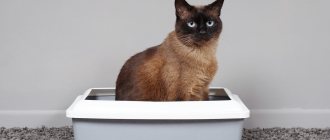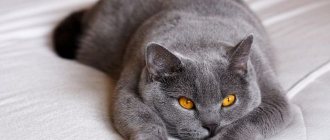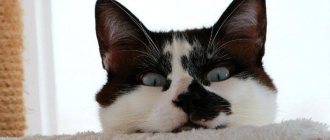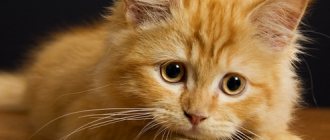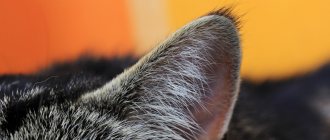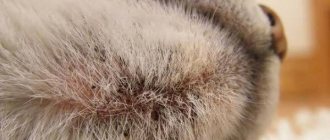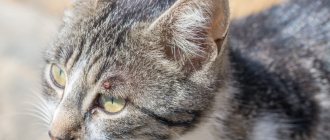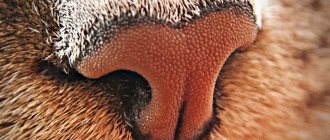Each of your cat's ears is controlled by a complex system of thirty-two muscles. Just imagine!
Thirty-two power cords, each of which can contract and relax with different tension. Incredible! For comparison, humans have only six muscles that control ear movement.
This entire amazingly complex system allows the cat to control its ears autonomously. that is, if necessary, direct them in different directions. In addition, a cat turns its ear in the direction of an unexpected sound signal ten times faster than a dog, and is also able to accurately judge its volume, speed and location from where it comes. To do this, the cat's ears can rotate 180 degrees, press against the head, and change their shape.
A cat’s ability to hear and distinguish sounds is very high, which is not surprising - with such “acoustic equipment”! But what is especially interesting for owners is that by the position of a cat’s ears one can judge its emotions and it is quite easy to figure out what it is feeling at the moment. So let's observe and remember.
The cat is interested in something
Remember the saying: “Keep your ears to the ground”? This is exactly the case - the ears stand almost vertically and only slightly turn from side to side. The cat listens to something important and interesting for it and will try to get as much information about it as possible by catching the location of the sound source in space. You can notice such ear movements when a cat hears the chirping of birds outside the window, hunts a flying fly, or pays attention to the rustling of a supposed mouse somewhere behind the wall.
Hot ears in a cat: how to find out and eliminate the cause? (3 photos)
In order to provide timely help to the animal, it is necessary to remember what the cat was doing immediately before the appearance of alarming symptoms. If the pet was resting, playing, or there was stress, then this reaction is normal: no additional actions need to be taken.
If an animal often rests in the heat, heat or sunstroke may occur, as is the case with people. And the manifestations of this will be disorientation in space, fainting, loss of consciousness. The cat needs to be moved to the shade or a cool room, given a drink, and gently moistened its paws and belly with cool water. If activity returns after following these steps, no further assistance is needed. When the pet remains indifferent, apathetic and indifferent to everything that is happening, weak, then you need to measure its temperature. If it increases, you should immediately contact a veterinarian, since an elevated temperature may indicate an infectious disease that requires professional intervention.
Along with an increase in the temperature of the auricle, a cat may also experience a symptom such as the appearance of discharge. With a high degree of probability in such a situation we can talk about otitis media. In this case, you need to seek professional help. Never clean the ear canal with your own hands. This can worsen the situation and complicate diagnosis. Otitis media can be caused by bacteria, fungi or ear mites, and the selection of effective drugs depends on the result of the analysis for which a smear is taken from the ear.
Hot ears accompanied by a rash are a clear sign of an allergic reaction. Especially if the pet is at the same time intensely itching, nervous, or worried. You can give her cetirizine to stop the attack. But you need to understand that an antihistamine is not a medicine. It is necessary to identify the root cause and eliminate the allergen. Most often, this role is played by a flowering indoor or outdoor plant, new food, household chemicals, or parasites.
Thus, hot ears on an animal do not pose anything dangerous. If other alarming symptoms are not observed at the same time, there is no need to worry. The most attentive and restless owners can be advised to watch the cat for a while. If there is cause for concern, the animal will soon let you know about it.
The cat feels angry, angry, ready to show aggression
In such a situation, the position of the ears, as a rule, is not the only and not the most striking sign, but at the same time very characteristic. The cat's ears are directed to the sides, because there is no longer a need to listen to something, to understand the situation - it is clear. As they say, the time for talking is over! Now you need to scare the enemy as much as possible by making yourself visually larger - arch your back, ruffle your fur, or, for starters, spread your ears to the sides like this. However, if the cat is not sure of victory and is ready to retreat, then its ears still move slightly, then pressing against the head, then spreading out to the sides again.
The structure of cat ears
The ear anatomy of this animal is complex. Like most mammals, cats' hearing organ consists of three parts. :
- Outer ear.
- Average.
- Internal.
© shutterstock
Let's take a closer look at the structure of each part.
Outer ear
This part includes the visible areas and recesses to the membrane. Most cat breeds have straight, erect ears. There are only a few breeds with folded, floppy ears.
The cartilage of the outer ear is slightly concave, covered with hair on the outside and delicate skin and long thin hairs on the inside.
The visible concha extends into the ear canal with a thin pink skin. The sulfur glands are located in this part. Cats' sulfur is not yellow, like humans', but brown. In a healthy individual, there are practically no accumulations of sulfur in the canal.
At the very end of the ear canal is a membrane. It is invisible from the outside and well protected by the almost 90 degree bend of the channel. You could say that the membrane is “around the corner.” Nature has made sure that the most important organ is reliably sheltered from external factors and protected from injury.
Middle ear
To understand the invisible structure of a cat’s ear, you can look at the photo. Next, the system moves to the middle part, located behind the membrane. The anatomical location of the middle hearing aid is a bony cavity located at the base of the skull. Three thin bones growing in this “pocket” receive sounds from the eardrum and reflect them into the middle ear. The path of sound passes through a bubble filled with air. Its role is to amplify sound vibrations.
© shutterstock
Inner ear
The cat's inner ear is the deepest part of the entire hearing system. Here the ear canal is protected by the temporal bone. The inner ear contains the most important organ of Corti. It is he who converts the sound waves received from the eardrum into electrical impulses transmitted to the brain through neural networks.
In addition, in this area the cat has a vestibular apparatus - 3 small semicircular canals filled with liquid. The canals contain microscopic hairs. Any movement of the fluid is detected by hairs that generate nerve impulses. Receiving these signals, the brain determines the position of the body, the horizon line, where is down, where is up, and the cat maintains the balance of its body.
Thus, a cat's ears consist not only of a system that receives sounds, but also of organs that help the animal balance its movements.
Treatment of ear diseases in cats
Treatment for ear diseases in the initial stages is quite easy. no more than 2 days have passed since the formation of the hematoma Next, it is recommended to use heat compresses to quickly resolve the hematoma, and also apply ointments that have an irritating effect. If home methods are not effective, it is recommended to contact a veterinarian for help.
In a clinical setting, surgery can be performed under local anesthesia. The cat is immobilized and the hematoma is opened, thoroughly cleaning out the contents. Antibacterial drugs and absorbable ointments are prescribed.
when taking lymphoestrogen . You should not delay visiting a specialist. In a hospital setting, fluid is collected to determine the type of exudate. The leaked lymphatic fluid is collected with a syringe, and then corticosteroids are administered.
If there is necrosis of the auricle, treatment at home is unacceptable. The animal should be shown to a veterinarian. In a clinical setting, the doctor will conduct a thorough clinical examination and make a prognosis. In advanced cases, amputation of the entire auricle or the necrotic area is prescribed. Next, antibiotic therapy is carried out to prevent the development of pathogenic bacterial microflora.
If a foreign object is detected in the ear canal , it is removed using a special tool. It is not recommended to remove a foreign body at home, as there is a risk of pushing it into the deeper structures of the ear. After the veterinarian removes the foreign object, the ear is washed with an antiseptic solution. In order to reduce pain in the animal, an anesthetic drug may be prescribed.
Diagnosed tumors in the ear are removed exclusively by surgery. Only after resection of a benign or malignant tumor is there a possibility of a complete cure.
For otitis in a cat, treatment is developed individually based on the degree of neglect of the pathological inflammatory process. At the initial stages of the disease, special medications are prescribed. Depending on the nature of the pathology, antibiotics, antifungal drugs or histamine blockers are prescribed. Careful diagnostic measures can determine the presence of otitis in an animal. It is imperative to collect an anamnesis, take into account the conditions of the cat’s keeping, and examine the entire ear canal using an otoscope, and not just its outer part. The veterinarian will take samples (smears) from the ear and conduct further research.
Bent ear
Fold ear - based on this mutation, the Scottish Fold cat breed was created. It is dominant in nature, the mutant allele is designated by the symbol Fd (Folded ear). FdFd homozygotes have shortened limbs and a significantly shortened and immobilized tail. Fusion of the vertebrae and loss of mobility are often observed. These anomalies develop due to increased growth of bone epiphyses and a decrease in the rate of ossification. Similar skeletal changes, less pronounced and not found in all individuals, are also observed in Fdfd heterozygotes. The majority of heterozygous individuals are free from these anomalies and have a normal appearance. Kittens' ears develop normally until 3-4 weeks of age, and then fold forward. The auricle of these animals is somewhat reduced.
How to properly clean a cat's ears
Inflammation of the outer, middle and inner ear
Inflammation of the outer ear is usually the result of untreated or undertreated otodectosis. In addition, the cause of the disease can be sulfur plugs, a foreign object, or cold water.
Symptoms:
— At an early stage, the skin looks irritated and red.
— The cat rubs the sore ear (or ears with bilateral otitis media) with its paw, holding the ear folded and pressed to the head.
— After some time, the ear begins to hurt. If the pain is acute, “shooting,” the cat suddenly jumps up, screams sharply, and looks around in fear. If the pain is aching, the cat does not allow the ear to be touched, avoids stroking the head, and presses the sore ear to the bedding.
- Scratches, grooves, pimples, ulcers are noticeable on the skin;
— The cat constantly shakes its head, does not turn its sore ear to the rustle;
- If the facial nerve is damaged, the eyelid, lip or ear may sag, which indicates partial paralysis.
— If purulent otitis media develops, cats have a leak from the ear, something squelches and gurgles inside, especially when touched.
— An obsessive unpleasant odor emanates from a cat, especially from the ear.
- In severe cases, the temperature rises 1-2 degrees above normal, the pet loses appetite, does not want to play and communicate. Many cats become irritable and constantly scream and meow.
Treatment:
The first step is to remove the hair from the inner surface of the ear.
- Using a cotton swab, clean the external auditory canal from accumulated wax and purulent discharge. Cotton wool can be moistened in a warm solution of hydrogen peroxide (3%), boric acid (2%) or furatsilin solution.
- Then the remaining moisture from the rinsing is thoroughly blotted with a gauze cloth to dry the ear.
- Medicinal drops prescribed by the veterinarian are instilled into the auricle.
- Sometimes it is necessary to carry out a novocaine blockade to reduce pain. This procedure can only be performed by a qualified specialist in a manner that is safe for your pet’s health.
- A course of antibiotic therapy is prescribed for 5-7 days.
- Adequate nutrition with easily digestible feed, introduction of vitamin and mineral supplements into the diet.
============================================================================================================================================================================================


